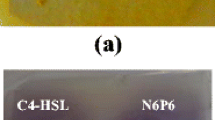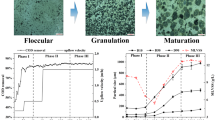Abstract
The N-acyl-homoserine lactones (AHLs)-mediated quorum-sensing (QS) system played a crucial role in regulating biological nitrogen removal and biofilm formation. However, the regulatory role of AHLs on nitrogen removal bacteria in high salinity environment has remained unclear. This study evaluated the roles and release patterns of AHLs in Vibrio sp. LV-Q1 under high salinity condition. Results showed that Vibrio sp. primarily secretes five AHLs, and the AHLs activity is strongly correlated with the bacterial density. Exogenous C10-HSL and 3OC10-HSL were found to significantly enhance ammonium removal, while making a minor contribution to the growth rate. Both the C10-HSL and 3OC10-HSL promoted the biofilm formation of Vibrio sp. with an enhancement of 1.64 and 1.78 times, respectively. The scanning electron microscope (SEM) and confocal laser scanning microscope (CLSM) observations confirmed the biofilm-enhancing effect of AHLs. Further analysis revealed that AHLs significantly improved bacterial self-aggregation and motility, as well as the level of extracellular polymeric substances (EPS). These findings provide significant guidance on construction of nitrification system at high salinity.
Graphical abstract








Similar content being viewed by others
Data availability
The original contributions presented in the study are included in the article/Supplementary material, and further inquiries can be directed to the corresponding author.
References
Wang YZ, Zhu T, Wong YJ, Zhang K, Chang MD (2023) Treatment performance of multi-stage active biological process (MSABP) reactor for saline sauerkraut wastewater: acclimatization, optimization and improvement. Bioproc Biosyst Eng 46(7):981–993. https://doi.org/10.1007/s00449-023-02877-2
Man QL, Zhang PL, Huang WQ, Zhu Q, He XL, Wei DS (2022) A heterotrophic nitrification-aerobic denitrification bacterium Halomonas venusta TJPU05 suitable for nitrogen removal from high-salinity wastewater. Front Env Sci Eng 16(6):69. https://doi.org/10.1007/s11783-021-1503-6
Zhang MR, Han F, Li YK, Liu Z, Chen H, Li Z, Li Q, Zhou WZ (2021) Nitrogen recovery by a halophilic ammonium-assimilating microbiome: a new strategy for saline wastewater treatment. Water Res 207:117832. https://doi.org/10.1016/j.watres.2021.117832
Ding R, Ding ZY, Chen XJ, Fu JL, Zhou ZJ, Chen X, Zheng X, Jin YC, Chen RY (2021) Integration of electrodialysis and Donnan dialysis for the selective separation of ammonium from high-salinity wastewater. Chem Eng J 405:127001. https://doi.org/10.1016/j.cej.2020.127001
Qin YJ, Wang KC, Xia Q, Yu SQ, Zhang MA, An Y, Zhao XD, Zhou Z (2023) Up-concentration of nitrogen from domestic wastewater: a sustainable strategy from removal to recovery. Chem Eng J 451:138789. https://doi.org/10.1016/j.cej.2022.138789
Corsino SF, Capodici M, Di PF, Tandoi V, Torregrossa M (2019) Comparison between kinetics of autochthonous marine bacteria in activated sludge and granular sludge systems at different salinity and SRTs. Water Res 148:425–437. https://doi.org/10.1016/j.watres.2018.10.086
Wang QQ, He SL, Yang W, Zhu JB, Zhang WK, Xue RZ, Liu LM (2022) The effects of salinity changes on anammox performance: the response rule and tolerance mechanism. Water Environ Res 94(9):e10789. https://doi.org/10.1002/wer.10789
Luo G, Wang Z, Li Y, Li J, Li AM (2019) Salinity stresses make a difference in the start-up of membrane bioreactor: performance, microbial community and membrane fouling. Bioproc Biosyst Eng 42(3):445–454. https://doi.org/10.1007/s00449-018-2048-3
Li JB, Ma JX, Sun L, Liu X, Liao HY, He D (2022) Mechanistic insight into the biofilm formation and process performance of a passive aeration ditch (PAD) for decentralized wastewater treatment. Front Env Sci Eng 16(7):86. https://doi.org/10.1007/s11783-021-1494-3
Zhang MR, Han F, Chen H, Yao JY, Li QY, Li Z, Zhou WZ (2022) The effect of salinity on ammonium-assimilating biosystems in hypersaline wastewater treatment. Sci Total Environ 829:154622. https://doi.org/10.1016/j.scitotenv.2022.154622
Zhang Q, Fu JJ, Wu QY, Chen JY, Fan NS, Huang BC, Jin RC (2021) Build the expressway for the salt-tolerant anammox process: acclimation strategy tells the story. J Clean Prod 278:123921. https://doi.org/10.1016/j.jclepro.2020.123921
Zuo LS, Yao H, Chen H, Li HY, Jia FX, Guo JH (2021) The application of glycine betaine to alleviate the inhibitory effect of salinity on one-stage partial nitritation/anammox process. Water Environ Res 93:549–558. https://doi.org/10.1002/wer.1457
Singha LP, Shukla P (2023) Microbiome engineering for bioremediation of emerging pollutants. Bioproc Biosyst Eng 46(3):323–339. https://doi.org/10.1007/s00449-022-02777-x
Whiteley M, Diggle SP, Greenberg EP (2017) Progress in and promise of bacterial quorum sensing research. Nature 551:313–320. https://doi.org/10.1038/nature24624
Zhao ZC, Xie GJ, Liu BF, Xing DF, Ding J, Han HJ, Ren NQ (2021) A review of quorum sensing improving partial nitritation-anammox process: functions, mechanisms and prospects. Sci Total Environ 765:142703. https://doi.org/10.1016/j.scitotenv.2020.142703
Cheng Y, Zhang Y, Shen QX, Gao J, Zhuang GQ, Zhuang XL (2017) Effects of exogenous short-chain N-acyl-homoserine lactone on denitrifying process of Paracoccus denitrificans. J Environ Sci 54:33–39. https://doi.org/10.1016/j.jes.2016.05.019
Wang XJ, Wang WQ, Li Y, Zhang J, Zhang Y, Li J (2018) Biofilm activity, ammonia removal and cell growth of the heterotrophic nitrifier, Acinetobacter sp., facilitated by exogenous N-acyl-homoserine lactones. Rsc Adv 8:30783–30793. https://doi.org/10.1039/c8ra05545a
Gao W, Hu YC, Jiao XH, Gao MM, Wang XH (2021) Recovery of structure and activity of disintegrated aerobic granular sludge after long-term storage: effect of exogenous N-acyl-homoserine lactones. Chemosphere 281:130894. https://doi.org/10.1016/j.chemosphere.2021.130894
Sun ZQ, Xi JY, Yeung M, Lu LC (2022) Two quorum sensing enhancement methods optimized the biofilm of biofilters treating gaseous chlorobenzene. Sci Total Environ 807:150589. https://doi.org/10.1016/j.scitotenv.2021.150589
Liu LJ, Xu SH, Wang F, Yan Z, Tian ZK, Ji M (2021) Effect of exogenous N-acyl-homoserine lactones on the anammox process at 15 °C: nitrogen removal performance, gene expression and metagenomics analysis. Bioresour Technol 341:125760. https://doi.org/10.1016/j.biortech.2021.125760
Henke JM, Bassler BL (2004) Three parallel quorum-sensing systems regulate gene expression in Vibrio harveyi. J Bacteriol 186(20):6902–6914. https://doi.org/10.1128/JB.186.20.6902-6914.2004
Wang Y, Wang H, Liang W, Hay AJ, Zhong Z, Kan B, Zhu J (2013) Quorum sensing regulatory cascades control Vibrio fluvialis pathogenesis. J Bacteriol 195(16):3583–3589. https://doi.org/10.1128/JB.00508-13
Bao JJ, Guo DK, Jin L, Li TJ, Shi H (2022) Accurate identification of diverse N-acyl homoserine lactones in marine Vibrio fluvialis by UHPLC-MS/MS. Curr Microbiol 79:181. https://doi.org/10.1007/s00284-022-02879-5
Yang Q, Han Y, Zhang XH (2011) Detection of quorum sensing signal molecules in the family Vibrionaceae. J Appl Microbiol 110(6):1438–1448. https://doi.org/10.1111/j.1365-2672.2011.04998.x
Wang MZ, Zheng X, He HZ, Shen DS, Feng HJ (2012) Ecological roles and release patterns of acylated homoserine lactones in Pseudomonas sp. HF-1 and their implications in bacterial bioaugmentation. Bioresour Technol 125:119–126. https://doi.org/10.1016/j.biortech.2012.08.116
Wang Y, Chen H, Liu YX, Ren RP, Lv YK (2015) Effect of temperature, salinity, heavy metals, ammonium concentration, pH and dissolved oxygen on ammonium removal by an aerobic nitrifier. Rsc Adv 5:79988–79996. https://doi.org/10.1039/c5ra13318a
Li HX, Xu SS, Wang S, Yang JX, Yan P, Chen YP, Guo JS, Fang F (2020) New insight into the effect of short-term exposure to polystyrene nanoparticles on activated sludge performance. J Water Process Eng 38:101559. https://doi.org/10.1016/j.jwpe.2020.101559
Eboigbodin KE, Biggs CA (2008) Characterization of the extracellular polymeric substances produced by Escherichia coli using infrared spectroscopic, proteomic, and aggregation studies. Biomacromol 9:686–695. https://doi.org/10.1021/bm701043c
Feng Q, Luo LW, Chen XD, Zhang KJ, Fang F, Xue ZX, Li C, Cao JS, Luo JY (2021) Facilitating biofilm formation of Pseudomonas aeruginosa via exogenous N-Acy-L-homoserine lactones stimulation: regulation on the bacterial motility, adhesive ability and metabolic activity. Bioresour Technol 341:125727. https://doi.org/10.1016/j.biortech.2021.125727
Lowry OH, Rosebrough NJ, Farr AL, Randall RJ (1951) Protein measurement with the Folin phenol reagent. J Biol Chem 193(1):265–275
Dubois M, Gilles KA, Hamilton JK, Rebers PA, Smith F (1956) Colorimetric method for determination of sugars and related substances. Anal Chem 28(3):350–356
Xu YB, Wang BS, Wang GZ, Zhang Y (2022) Degradation of refractory organics in the pharmaceutical wastewater by bioelectrochemical system. Chem Ind Eng Prog 41(9):5055–5064. https://doi.org/10.16085/j.issn.1000-6613.2021-2421
Gao M, Liu YJ, Liu Z, Li HT, Zhang AN (2020) Dynamic characteristics of AHLs-secreting strain Aeromonas sp. A-L2 and its bioaugmentation during quinoline biodegradation. J Appl Microbiol 128(4):1060–1073. https://doi.org/10.1111/jam.14530
Rather MA, Gupta K, Mandal M (2021) Microbial biofilm: formation, architecture, antibiotic resistance, and control strategies. Braz J Microbiol 52:1701–1718. https://doi.org/10.1007/s42770-021-00624-x
Wang YS, Bian ZR, Wang Y (2022) Biofilm formation and inhibition mediated by bacterial quorum sensing. Appl Microbiol Biot 106:6365–6381. https://doi.org/10.1007/s00253-022-12150-3
Jia FX, Peng YZ, Li JW, Li XY, Yao H (2021) Metagenomic prediction analysis of microbial aggregation in anammox-dominated community. Water Environ Res 93:2549–2558. https://doi.org/10.1002/wer.1529
Laverty G, Gorman SP, Gilmore BF (2014) Biomolecular mechanisms of Pseudomonas aeruginosa and Escherichia coli biofilm formation. Pathogens 3(3):596–632. https://doi.org/10.3390/pathogens3030596
Ipina EP, Otte S, Pontier BR, Czerucka D, Peruani F (2019) Bacteria display optimal transport near surfaces. Nat Phys 15(6):610–615. https://doi.org/10.1038/s41567-019-0460-5
Klausen M, Heydorn A, Ragas P, Lambertsen L, Aaes JA, Molin S, Tolker NT (2003) Biofilm formation by Pseudomonas aeruginosa wild type, flagella and type IV pili mutants. Mol microbiol 48(6):1511–1524. https://doi.org/10.1046/j.1365-2958.2003.03525.x
Mukherjee S, Bhattacharjee S, Paul S, Nath S, Paul S (2023) Biofilm: a syntrophic consortia of microbial cells: boon or bane? Appl Biochem Biotech 195:5583–5604. https://doi.org/10.1007/s12010-022-04075-4
Seviour T, Derlon N, Dueholm MS, Flemming HC, Girbal NE, Horn H, Kjelleberg S, van Loosdrecht MCM, Lotti T, Malpei MF, Nerenberg R, Neu TR, Paul E, Yu HQ, Lin YM (2019) Extracellular polymeric substances of biofilms: suffering from an identity crisis. Water Res 151:1–7. https://doi.org/10.1016/j.watres.2018.11.020
Li JJ, Jiang ZQ, Chen SS, Wang T, Jiang L, Wang MX, Wang SM, Li Z (2019) Biochemical changes of polysaccharides and proteins within EPS under Pb (II) stress in Rhodotorula mucilaginosa. Ecotox Environ Safe 174:484–490. https://doi.org/10.1016/j.ecoenv.2019.03.004
Chen W, Westerhoff P, Leenheer JA, Booksh K (2003) Fluorescence excitation-emission matrix regional integration to quantify spectra for dissolved organic matter. Environ Sci Technol 37:5701–5710. https://doi.org/10.1021/es034354c
Zhou RX, Ma XR, Li J, Zhang LH, Zhang J, Zhang YC, Han H (2021) Effects of AHLs at low temperature on the characteristics of mature biofilms in aerobic zone of multi-stage A/O technology. China Environ Sci 41(5):2133–2140. https://doi.org/10.19674/j.cnki.issn1000-6923.2021.0225
Schuster M, Lostroh CP, Ogi T, Greenberg EP (2003) Identification, timing, and signal specificity of Pseudomonas aeruginosa quorum-controlled genes: a transcriptome analysis. J Bacteriol 185:2066–2079. https://doi.org/10.1128/JB.185.7.2066-2079.2003
Sun YP, Guan YT, Wang D, Liang K, Wu GX (2018) Potential roles of acyl homoserine lactone based quorum sensing in sequencing batch nitrifying biofilm reactors with or without the addition of organic carbon. Bioresour Technol 259:136–145. https://doi.org/10.1016/j.biortech.2018.03.025
Burton EO, Read HW, Pellitteri MC, Hickey WJ (2005) Identification of acyl-homoserine lactone signal molecules produced by Nitrosomonas europaea strain Schmidt. Appl Environ Microbiol 71(8):4906–4909. https://doi.org/10.1128/AEM.71.8.4906-4909.2005
Ma F, Sun YL, Li A, Zhang XN, Yang JX (2015) Activation of accumulated nitrite reduction by immobilized Pseudomonas stutzeri T13 during aerobic denitrification. Bioresour Technol 187:30–36. https://doi.org/10.1016/j.biortech.2015.03.060
Galloway W, Hodgkinson JT, Bowden SD, Welch M, Spring DR (2011) Quorum sensing in Gram-negative bacteria: small-molecule modulation of AHL and Al-2 quorum sensing pathways. Chem Rev 111(1):28–67. https://doi.org/10.1021/cr100109t
Rabaey K, Boon N, Hofte M, Verstraete W (2005) Microbial phenazine production enhances electron transfer in biofuel cells. Environ Sci Technol 39:3401–3408. https://doi.org/10.1021/es048563o
Warrier A, Satyamoorthy K, Murali TS (2021) Quorum-sensing regulation of virulence factors in bacterial biofilm. Future Microbiol 16(13):1003–1021. https://doi.org/10.2217/fmb-2020-0301
Hall SL, Costerton JW, Stoodley P (2004) Bacterial biofilms: from the natural environment to infectious diseases. Nat Rev Microbiol 2(2):95–108. https://doi.org/10.1038/nrmicro821
Flemming HC, Wingender J (2010) The biofilm matrix. Nat Rev Microbiol 8(9):623–633. https://doi.org/10.1038/nrmicro2415
Funding
This work was supported by the Shanxi Province Science Foundation for Youths (Grant No. 20210302124348 and 202103021223099), Shanxi-Zheda Institute of Advanced Materials and Chemical Engineering (Grant No. 2021SX-AT004), and the National Natural Science Foundation of China (Grant No. 51778397).
Author information
Authors and Affiliations
Contributions
ZG conceived and designed the research, analyzed the data, and drafted the article. YW participated in data analysis. HC contributed to the data analysis and revision of the manuscript. YL revised the manuscript. All the authors read and approved the final manuscript.
Corresponding authors
Ethics declarations
Conflict of interest
The authors declare no competing interests.
Additional information
Publisher's Note
Springer Nature remains neutral with regard to jurisdictional claims in published maps and institutional affiliations.
Supplementary Information
Below is the link to the electronic supplementary material.
Rights and permissions
Springer Nature or its licensor (e.g. a society or other partner) holds exclusive rights to this article under a publishing agreement with the author(s) or other rightsholder(s); author self-archiving of the accepted manuscript version of this article is solely governed by the terms of such publishing agreement and applicable law.
About this article
Cite this article
Gao, Z., Wang, Y., Chen, H. et al. Facilitating nitrification and biofilm formation of Vibrio sp. by N-acyl-homoserine lactones in high salinity environment. Bioprocess Biosyst Eng 47, 325–339 (2024). https://doi.org/10.1007/s00449-023-02962-6
Received:
Accepted:
Published:
Issue Date:
DOI: https://doi.org/10.1007/s00449-023-02962-6




